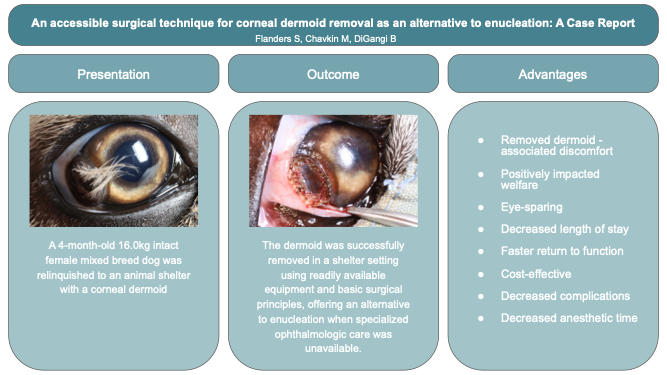An Accessible Surgical Technique for Corneal Dermoid Removal as an Alternative to Enucleation: A Case Report
DOI:
https://doi.org/10.56771/jsmcah.v3.110Keywords:
ophthalmology, veterinary, corneal dermoidectomy, pseudopterygium, canine, animal welfare, case reportAbstract
Corneal dermoids compromise ocular health and comfort. Dermoids are made up of cutaneous tissues, often including long hairs. When these hairs contact the cornea or other surrounding tissues, they can result in pain and discomfort. In resource-limited environments, veterinarians often perform enucleation of the affected eye to relieve the discomfort associated with corneal dermoids. This report describes a novel surgical technique to remove a canine corneal dermoid in a shelter using readily available equipment and basic surgical principles. Successful outcome supports an alternative to enucleation and/or referral for treatment of corneal dermoids. Although this procedure may result in decreased corneal clarity at the surgical site, the clinical outcome is acceptable and should be considered when access to specialized equipment and care is not feasible.
Downloads
References
1.
Badanes Z, Ledbetter EC. Ocular dermoids in dogs: a retrospective study. Vet Ophthalmol. 2019;22:760–766. doi: 10.1111/vop.12647
2.
Gelatt KN, Ben-Shlomo G, Gilger BC, Kern TJ, Plummer CE. Veterinary Ophthalmology. Hoboken, NJ: John Wiley & Sons; 2021.
3.
Gunter LM, Gilchrist RJ, Blade EM, et al. Emergency fostering of dogs from animal shelters during the COVID-19 pandemic: Shelter practices, foster caregiver engagement, and dog outcomes. Front Vet Sci. 2022;9:862590. doi: 10.3389/fvets.2022.862590
4.
Wiltzius AJ, Blackwell MJ, Krebsbach SB, et al. Access to Veterinary Care: Barriers, Current Practices, and Public Policy. 2018. https://pphe.utk.edu/wp-content/uploads/2020/09/avcc-report.pdf. Accessed June 4, 2024.
5.
Program for Pet Health Equity Center for Behavioral Health Research. Incremental Veterinary Care Guide. 2023. https://pphe.utk.edu/wp-content/uploads/2023/03/AlignCare-Incremental-Care-Guide.pdf. Accessed June 4, 2024.
6.
Shelter Medicine Veterinarians Facebook Group. Examples of Shelter Veterinarians and their Searches for Alternatives to Enucleation and Experimental Techniques. https://www.facebook.com/groups/186499308373730/search/?q=dermoid. Accessed July 19 2024.
7.
Pockett J, Orr B, Hall E, Chong WL, Westman M. Investigating the impact of indemnity waivers on the length of stay of cats at an Australian Shelter. Animals. 2019;9(2):50. doi: 10.3390/ani9020050
8.
Mellor DJ, Beausoleil NJ, Littlewood KE, et al. The 2020 five domains model: including human–animal interactions in assessments of animal welfare. Animals. 2020;10(10):1870. doi: 10.3390/ani10101870
9.
Veterinary Information Network. Describes Physical Limitations Associated with Enucleations. https://veterinarypartner.vin.com/default.aspx?pid=19239&id=4951449. Accessed July 25, 2024.
10.
Ward AA, Neaderland MH. Complications from residual adnexal structures following enucleation in three dogs. J Am Vet Med Assoc. 2011;239(12):1580–1583. doi: 10.2460/javma.239.12.1580
11.
Joussen AM, Poulaki V, Mitsiades N, et al. VEGF-dependent conjunctivalization of the corneal surface. Investig Ophthalmol Vis Sci. 2003;44(1):117. doi: 10.1167/iovs.01-1277
12.
Gelatt KN. Wsava state of the art lecture. J Small Anim Pract. 1997;38(8):328–335. doi: 10.1111/j.1748-5827.1997.tb03479.x

Additional Files
Published
How to Cite
Issue
Section
License
Copyright (c) 2024 Sarah Flanders, Matthew Chavkin, Brian DiGangi

This work is licensed under a Creative Commons Attribution 4.0 International License.








